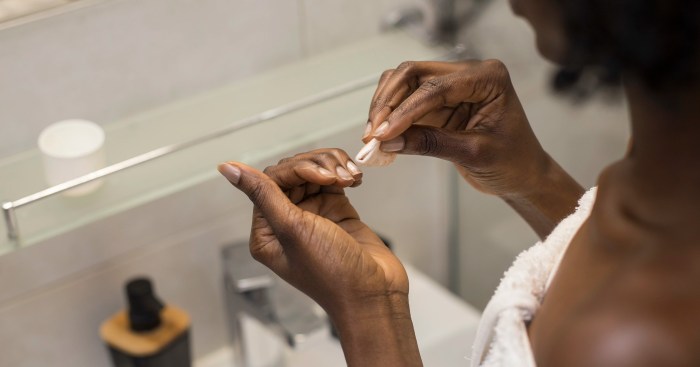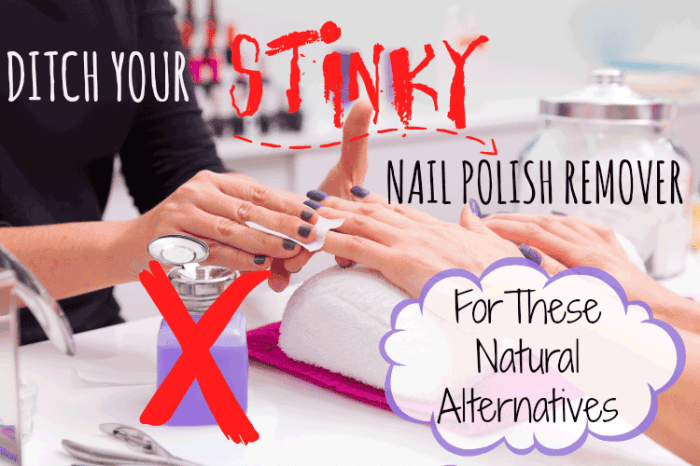What Can Be Used Instead of Nail Polish Remover?
Safe and Effective Nail Polish Removal Alternatives
What can be used instead of nail polish remover – Removing nail polish doesn’t always require harsh chemicals. This article explores various natural alternatives, household items, and commercially available acetone-free options, offering safer and more environmentally friendly ways to achieve clean, polish-free nails. We will also delve into preventative measures and DIY recipes to minimize the need for strong solvents and enhance nail health.
Natural Alternatives to Nail Polish Remover
Several natural ingredients possess properties that can effectively dissolve nail polish. Their effectiveness varies depending on the type of polish and the ingredient’s concentration. It’s crucial to note that these methods might require more time and effort compared to commercial removers.
| Ingredient | Method of Use | Effectiveness | Potential Drawbacks |
|---|---|---|---|
| White Vinegar | Soak cotton pads in white vinegar and hold against nails for several minutes. | Moderate; works best on lighter polishes. | Can be drying to nails and skin; strong odor. |
| Lemon Juice | Soak cotton pads in fresh lemon juice and apply to nails. | Moderate; more effective on lighter colors. | Can be drying; may cause skin irritation in some individuals. |
| Baking Soda | Make a paste with baking soda and water, gently scrub nails. | Low; best for removing residue or smudges. | Can be abrasive; may scratch nails if used too vigorously. |
| Rubbing Alcohol (Isopropyl Alcohol) | Soak cotton pads in rubbing alcohol and gently wipe nails. | Moderate to High; effective on most polishes. | Can be drying; strong odor. |
The effectiveness of these natural ingredients stems from their chemical properties. For example, the acidity of lemon juice and vinegar helps to break down the polymer chains in nail polish, while the solvent properties of rubbing alcohol dissolve the polish. Baking soda’s abrasive nature helps to physically remove the polish.
Compared to commercial removers, natural alternatives are generally gentler but less efficient. They may require repeated applications and more time for complete removal.
Infographic Illustration (Conceptual): Imagine a three-panel infographic. Panel 1 shows soaking cotton pads in white vinegar. Panel 2 depicts gently scrubbing nails with a baking soda paste. Panel 3 illustrates wiping nails with a cotton pad soaked in rubbing alcohol. Each panel includes clear, concise instructions and a visual representation of the process.
Household Items as Nail Polish Remover Substitutes
Several common household items can serve as substitutes for nail polish remover, offering convenient and readily available alternatives. However, their effectiveness varies, and some may require more patience and effort.
- High Effectiveness/Ease of Use: Rubbing alcohol (isopropyl alcohol)
- Moderate Effectiveness/Ease of Use: White vinegar, hand sanitizer (containing alcohol)
- Low Effectiveness/Ease of Use: Toothpaste (for removing minor smudges)
Step-by-Step Guide for Using White Vinegar:
- Soak cotton balls or pads in undiluted white vinegar.
- Hold the soaked cotton against each nail for 2-3 minutes.
- Gently wipe away the softened nail polish.
- Repeat as necessary. If the polish is stubborn, you might gently buff with a soft nail brush.
- Wash your hands thoroughly afterward.
Safety Tip: Avoid getting vinegar in your eyes. If irritation occurs, rinse with water immediately.
Acetone-Free Commercial Alternatives
Several brands offer acetone-free nail polish removers. These typically utilize ethyl acetate or other less harsh solvents as their primary ingredient. While generally gentler, they might require more time and effort for complete removal.
Example Acetone-Free Removers (Conceptual): Brand A (ethyl acetate, vitamin E), Brand B (ethyl acetate, aloe vera), Brand C (a blend of plant-derived solvents).
Acetone-free removers are often considered less drying to nails and surrounding skin compared to acetone-based products. However, their environmental impact is comparable; the specific impact depends on the solvents used and their biodegradability.
The technique for using acetone-free removers is similar to using acetone-based removers, although it might require more patience and gentle rubbing.
Preventing Nail Polish Staining and Removal Difficulties, What can be used instead of nail polish remover

Source: popsugar-assets.com
Proper nail care techniques can significantly reduce staining and simplify the removal process. This includes applying a base coat to protect the nail bed, using a top coat to seal the color, and choosing high-quality polishes.
Checklist (Before & After):
- Before: Apply a base coat; allow it to dry completely before applying color.
- After: Gently remove excess polish around the cuticles; use a cuticle pusher if necessary.
- After: Apply cuticle oil to moisturize and condition the skin around nails.
Base and top coats create a barrier between the nail and the polish, making removal easier and reducing the likelihood of staining. The base coat protects against discoloration, while the top coat seals the color, preventing chipping and making the polish last longer.
Seeking alternatives to harsh nail polish remover? Several household items can gently lift polish, including white vinegar or even toothpaste. For a more thorough method focusing on acetone-free removal, check out this helpful guide on how to take off nail polish without acetone. Ultimately, the best substitute for nail polish remover depends on your nail type and the polish itself.
DIY Nail Polish Remover Recipes

Source: simplepurebeauty.com
Several DIY recipes offer cost-effective and customizable alternatives to commercial removers. However, their effectiveness may vary depending on the quality of ingredients and the type of nail polish.
| Ingredients | Instructions | Notes |
|---|---|---|
| Equal parts rubbing alcohol and lemon juice | Mix ingredients; soak cotton pads and apply to nails. | Moderately effective; may be drying. |
| Rubbing alcohol and a few drops of essential oil (e.g., lavender) | Mix ingredients; soak cotton pads and apply to nails. | Moderately effective; adds pleasant scent. |
| White vinegar and a few drops of olive oil | Mix ingredients; soak cotton pads and apply to nails. | Less effective than alcohol-based solutions; gentler on nails. |
Creating a Rubbing Alcohol and Lemon Juice Remover: Mix equal parts of rubbing alcohol and freshly squeezed lemon juice in a small container. Soak cotton balls or pads in the mixture and apply to nails, gently wiping away the polish. Remember to avoid contact with eyes and skin.
Question & Answer Hub: What Can Be Used Instead Of Nail Polish Remover
Can I use rubbing alcohol to remove nail polish?
Rubbing alcohol can remove nail polish, but it may be less effective than acetone and can dry out your nails.
Is it safe to use nail polish remover on artificial nails?
Always check the instructions for your specific artificial nails before using any nail polish remover. Some removers can damage artificial nails.
What’s the best way to prevent nail staining?
Apply a base coat before your nail polish and a top coat afterwards. This helps create a barrier between the polish and your nail.
How often should I change my nail polish remover?
The frequency depends on usage, but generally, it’s a good idea to replace your nail polish remover every few months to ensure its effectiveness.















